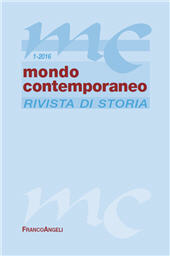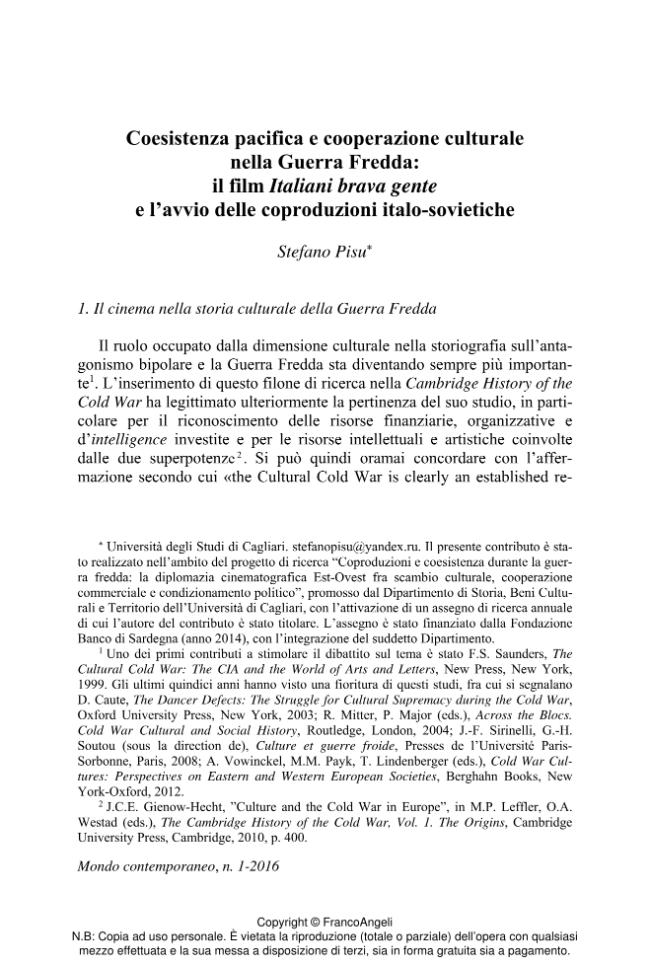Coesistenza pacifica e cooperazione culturale nella Guerra Fredda : il film Italiani brava gente e l'avvio delle coproduzioni italo-sovietiche
P. 35-62 p.
Il saggio ricostruisce la genesi e la lavorazione del film di Giuseppe De Santis Italiani brava gente (1964), che narra la campagna militare italiana in Unione So-vietica durante la seconda guerra mondiale. Il film fu il primo a coproduzione ita-lo-sovietica e costituì un precedente per la firma nel 1967 dell'accordo intergover-nativo. Il contributo rivela le connessioni e i cortocircuiti legati alle coproduzioni fra Est e Ovest nell'ambito della "Guerra Fredda culturale", seppure nella fase del-la coesistenza pacifica. Dal punto di vista creativo e culturale, alla volontà di fare un film sull'amicizia fra i due popoli, si aggiunse la rappresentazione del "cattivo tedesco" affermatasi, con finalità e modi differenti, in entrambi i paesi. A livello politico e ideologico la cooperazione fu messa in crisi dal riemergere fra i sovietici di un atteggiamento di sospetto verso il produttore italiano, che aveva ricevuto un finanziamento americano per realizzare il film, e anche verso il Pci, che aveva so-stenuto il p
rogetto. L'idea e la lavorazione del film testimoniano la volontà di con-solidare i buoni rapporti fra i due paesi negli anni Sessanta, rivelando al contempo una difficoltà comunicativa fra comunisti sovietici e italiani che nel corso del de-cennio si sarebbe palesata più chiaramente. L'esperienza di Italiani brava gente mostra comunque una cortina di ferro permeabile attraverso l'atteggiamento ne-goziale di tutti gli attori coinvolti.
This article deals with the origins and making of Giuseppe De Santis' film Ital-iani brava gente (1964) that depicts the Italian military campaign in the Ussr dur-ing the Second World War. This was the first Italian-Soviet film co-production and paved the way for the signing of the intergovernmental agreement in 1967. The essay reveals challenges and problems of the East-West film co-productions and the cultural dimension of the Cold War at the time of so-called peaceful coexist-ence. From the creative and cultural point of view, the director's intent to make a film on the friendship between Soviet and Italian peoples went along with the rep-resentation of the "bad German", a widespread image in both countries. The Ital-ian-Russian cooperation, however, was jeopardized by political and ideological reasons, in particular by the suspicious attitude of the Soviets towards the produc-ers, who received an American grant to finance the production, as well as towards the Italian Communist Party, who supported the pr
oject. The idea that stood be-hind the movie, and the film making itself, prove that both countries aimed to strengthen their good bilateral relations in the 1960s. At the same time, however, the difficulties of the whole project reveal a problem of communication between Soviet and Italian Communists, that would eventually degenerate in the following years. Nevertheless, the case of Italiani brava gente demonstrates also that the Iron Curtain was penetrable and that the negotiating attitude of all the people in-volved in the production made it possible to go across it.
Forma parte de
Mondo contemporaneo : rivista di storia : 1, 2016-
Artículos del mismo número (disponibles individualmente)
-
Información
Código DOI: 10.3280/MON2016-001002
ISSN: 1972-4853
KEYWORDS
- Guerra Fredda culturale
- Industria cinematografica
- Coproduzioni cinematografiche internazionali
- Relazioni italo-sovietiche
- Coesistenza pacifica
- Giuseppe De Santis
- Cultural Cold War.
- Film industry
- International film co-productions
- Soviet-Italian relations
- Peaceful co-existence



